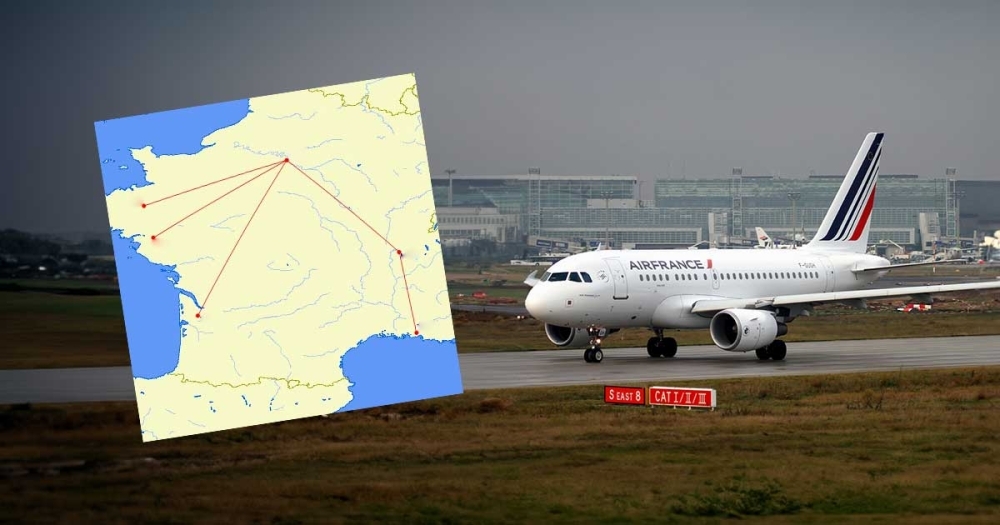France has become the first country in the EU to ban short-haul flights. The country has abolished several domestic air routes that can be covered by train in 2.5 hours or less.
Since the publication of the White Paper on Transport Policy in 2001, there have been significant changes in air, road, and rail transport. Despite the launch of the Single European Skies (SES) initiative and a number of measures taken to improve the environmental impact of transport, the sector is simply unsustainable in the long term. The European Green Deal aims for Member States to reduce greenhouse gas emissions from transport by 90 percent by 2050, compared to 1990. To help achieve this, the European Environment Agency (EEA) has examined the impacts of rail and air transport, both of which play an important role in passenger transport in Europe, in its 2020 Transport and Environment (TERM) Report. Although demand for air transport in general is steadily increasing, the high-speed rail network can replace a significant share of short and medium-haul air transport as a more sustainable alternative.
According to the EEA report, the shift from air to rail is a key feature of passenger transport. On a passenger-kilometer basis, emissions are much higher from aviation than from rail transport. The EU’s Sustainable and Smart Mobility Strategy (SWD (2020) 331 final) aims to achieve carbon neutrality in public transport routes under 500 kilometers and double the use of high-speed rail by 2030, thus helping to increase the shift towards more sustainable forms of transport in the EU.
The environmental performance of the aviation sector has taken the spotlight over the past three years, according to the European Union Aviation Safety Agency (EASA)’s European Aviation Environmental Report for 2022. Although the aviation sector’s share of global CO2 emissions remains at around 2.5 percent per year, it has increased dramatically in volume over recent years. As a result of the dynamic expansion of aviation, almost half (47 percent) of the industry’s CO2 emissions between 1940 and 2019 were generated from the 2000s onwards (EASA, 2022).
What could be behind the ban on short-haul flights?
The law may partly be the outcome of a pilot project launched by French President Macron in 2019, which saw 150 randomly selected people requested to design climate policy. The project proposed a ban on all flights that could be covered by rail in less than four hours before the conditions were eventually relaxed by the French legislature. On the other hand, the White Paper and the EU’s single transport policy objectives already included a preference for alternative forms of transport, such as rail and waterborne solutions, as well as restrictions on freight transportation by air.
Legislation on short-haul flights was first proposed in 2021 as part of the French climate protection law. During the COVID-19 pandemic, the government offered financial support to Air France to ensure its compliance with the ban, and competitors were prohibited from taking the national carrier’s place. Originally, a restriction on journeys of less than four hours was proposed, but the measure was relaxed in the face of opposition from the airline industry.
In reality, the final version of the law only affects three air routes: Paris-Orly to Bordeaux, Nantes, and Lyon. Traffic on these routes was already cut back in 2020, meaning that the ban essentially only ensures that these flights cannot be relaunched.
France is among the largest countries in the European Union; consequently, distances between major cities are considerable in a Hungarian comparison. Air transport would therefore seem to be an obvious option, especially between the most distant and densely populated municipalities. However, air traffic is so widespread in the country that it justifiably raises environmental and climate concerns.
The most popular domestic routes in France (with significant seasonal variation):
|
Routes |
Maximum number of return flights per day |
|
Paris – Nice |
72 |
|
Paris – Toulouse |
60 |
|
Paris – Marseille |
30 |
|
Paris – Bordeaux |
16 |
|
Paris – Montpellier |
16 |
|
Lyon – Bordeaux |
16 |
|
Lyon – Nantes |
14 |
|
Paris – Lyon |
12 |
|
Paris – Nantes |
12 |
|
Toulouse – Lyon |
12 |
|
Marseille – Bordeaux |
10 |
|
Nice – Lille |
8 |
|
Toulouse – Marseille |
8 |
|
Toulouse – Nantes |
8 |
In terms of the most popular routes, there are 294 domestic flights a day from French airports, almost one and a half times the daily number from Budapest Airport prior to COVID-19.
The carbon footprint of aviation can be calculated from fuel consumption per flight. Boeing 737-400 aircraft are typically used for short-haul international flight. To cover a distance of 926 km, an estimated 3.61 tonnes of fuel is emitted2 (Guidebook, 2001). Based on a seating capacity of 164 passengers and an average seat load factor of 65 percent, this translates into fuel consumption of 36.57 g per passenger per kilometer. Aircraft fuel consumption results in 3.15 g of CO2 emissions per 1 g of fuel, which equals 115 g of CO2 emissions per passenger per kilometer.2
According to data released by Carbon Independent, a passenger aircraft emits 101 grams of CO2 per passenger per kilometer over a distance of 5,556 kilometers and 333 passengers aboard. Take-off and landing are the most carbon-intensive parts of the flight; the longer the flight is, the lower average emissions per kilometer are, as the aircraft spends more time at lower-emission altitudes. For flights under 1,000 kilometers in France, therefore, even a low estimate of 101 grams of CO2 emissions per passenger per kilometer is a reasonable estimate.
Based on the above, a single domestic flight in France emits over 33,300 grams of CO2 per kilometer. This allows for the calculation of the daily emissions of the 14 most popular flight routes listed.
A single flight serving the Paris – Nice route emits 23 tonnes of CO2, meaning that for 72 flights a day, the entire route emits nearly 1,650 tonnes of CO2. The Paris – Toulouse flight emits around 19 tonnes of CO2, which is equivalent to 1,150 tonnes of CO2for 60 flights per day. The Paris – Marseille route emits 22 tonnes of CO2, which is equivalent to 660 tonnes of CO2 in the case of 30 flights per day. Emissions produced by further routes are as follows (emissions from a single flight rounded up to the nearest whole; emissions from all flights per day):
|
Route |
CO2 emission per flight |
CO2 emission per day |
|
Paris – Nice |
23 tonnes |
1650 tonnes |
|
Paris – Toulouse |
19 tonnes |
1150 tonnes |
|
Paris – Marseille |
22 tonnes |
660 tonnes |
|
Paris – Bordeaux |
17 tonnes |
270 tonnes |
|
Paris – Montpellier |
20 tonnes |
320 tonnes |
|
Lyon – Bordeaux |
15 tonnes |
245 tonnes |
|
Lyon – Nantes |
17 tonnes |
238 tonnes |
|
|
13 tonnes |
186 tonnes |
|
Paris – Nantes |
12 tonnes |
148 tonnes |
|
Toulouse – Lyon |
12 tonnes |
150 tonnes |
|
Marseille – Bordeaux |
17 tonnes |
166 tonnes |
|
Nice – Lille |
28 tonnes |
221 tonnes |
|
Toulouse – Marseille |
11 tonnes |
85 tonnes |
|
Toulouse – Nantes |
15 tonnes |
124 tonnes |
It is important to note that as the distance between cities (i.e., emissions per journey) decreases, the proportion of the flight spent taking off and landing increases, resulting in higher average emissions per kilometer. For shorter flights, the 33,000 grams of CO2 emissions per kilometer, as well as values per flight and all flights per day can be considered even more conservative estimates.
Taking all this into account, the 14 most popular domestic flights in France (not counting flights to Corsica) emit 5,613 tonnes of CO2 per day. If these flights were operated every day of the year, it would result in 2,048,745 tonnes of CO2 emissions per year. In this case, maximum values are featured for the number of flights, while emissions are a low estimate and only the most popular flights are taken into account.
It is calculated that annual CO2 emissions from domestic flights in France could exceed 2 million tonnes, even if flights to Corsica (which cannot be substituted by rail) are excluded.
According to TGV Lyra data, CO2 emissions per passenger are 66 times higher if the distance between two cities is covered by plane. The transportation of passengers over the same distance by TGV (high-speed train) would only result in 31,000 tonnes of CO2 emissions, which is over two million tonnes less CO2 than what is generated by flying. In other European countries, rail-based emissions could be higher, as TGVs are powered by electricity and 62.3 percent of French electricity generation was provided by carbon-neutral nuclear power plants in 2022 (IAEA, 2023; Statista, 2023).
However, current TGV infrastructure is unable to handle, for example, the mobility passengers aboard the 72 daily return flights between Paris and Nice. At the same time, further densification of rail services could still achieve major results, with minimal sacrifices on behalf of passengers.
We will not list the duration of all fourteen routes by air and by TGV, but a strong example is worth citing to illustrate the power of the latter. The Paris – Marseille route, popular both by plane and by TGV, takes 1 hour 20 minutes on the former and 3 hours 34 minutes on the latter. However, if airport transfers are taken into account (unlike airplanes, the train takes the passenger from city center to city center), together with check-in times and security checks, the difference between the two modes of transport is minimal.
Not all of the other 13 routes are served by a direct TGV service, meaning that not all of the nearly three hundred domestic flights can be replaced by equally comfortable routes. However, current infrastructure already allows for full or partial substitution of flights serving popular routes.
Overall, the new ban will not dramatically reduce emissions in France. However, it has the power to change mindsets and influence climate policy, as its application on a larger scale and its international expansion could bring about genuine progress in the field of global emissions.





